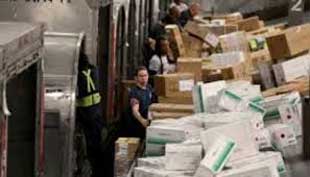| |
|
| |
|
 |
Supply
Chain by the Numbers |
| |
|
| |
- Sept. 20, 2018 -
|
| |
|
| |
|
| |
|
| |
UPS Investing Big in Peak Season Capacity; Now Union Pacific to Try Precision Railroading; IKEA Going All Green on Local Deliveries; US Truckload Rates Still Heading Higher, Much Higher |
| |
|
| |
| |
| |
| |
400,000 |
 |
That incredibly is how many additional packagers per hour UPS will be able to handle in the upcoming peak season versus 2017, the company said last week. That after the parcel delivery giant had some challenges processing huge volume days near Chistmas in recent years. The capacity enhancements come from a variety of network improvements, including a growing number automated hubs, and 40 new aircraft that will boost its air capacity by one-third. Chief Operating Officer Jim Barber also said UPS focused primarily on forecasting overall volumes in recent years, but this year it will zero in on where the packages are coming from and where they are headed, using - as we reported earlier this year - new home grown analytic software.
|
|
|
| |
| |
|
|
|
That’s the percent of last mile deliveries that will be made by Swedish home furnishings retailer IKEA using electric trucks or other zero emissions vehicles by 2025. To reach that goal, IKEA said it is now promising to have all its home deliveries in the urban core of five cities - Amsterdam, Los Angeles, New York, Paris and Shanghai – be through all electric by the end of 2020. Reuters reported last week that IKEA said that would mean 25% of its home deliveries would be zero-emission by that year. "For us it’s crucial to grow our business in a sustainable way - that’s why we’re speeding up the transition to EV in five inner city areas," IKEA Group CEO Jesper Brodin said in a statement. There seems to be no stopping the coming electric truck wave, especially for shorter daily routes as in local deliveries. |
| |
| |
|
| |
| |
| |
11.1% |
|
That was the year over year growth in August in the Cass Linehaul Index, which measures per mile US truckload rates before fuel surcharges and other accessorials, according to numbers released this week. That turns out to be highest monthly percentage increase in the history of this index, as US truckload freight shows no sign of slowing down as some other modes have. "We believe that this is the strongest normalized percentage level of truckload pricing achieved since deregulation (normalized meaning except for extreme periods of recovery from recession)," Donald Broughton, analyst and commentator for the Cass indexes. The year-over-year increases over the last five months have been 8.2%, 9.0%, 9.5%, 10.2% and now the 11.1% last month. Amazing. |
| |
| |
| |
|
|
|
| |
 |
 |
| |
|
|
| |